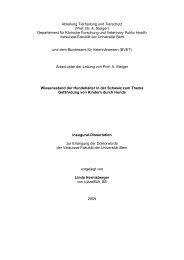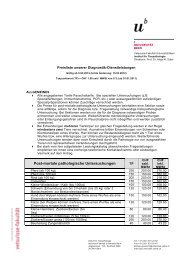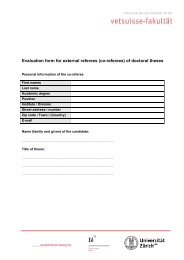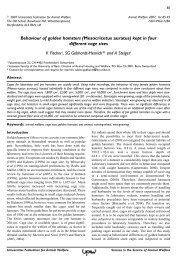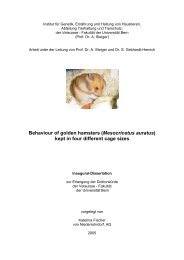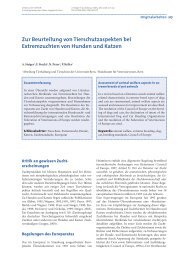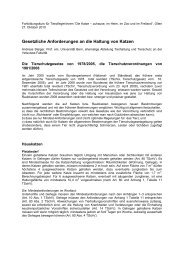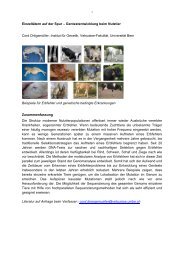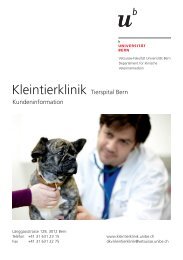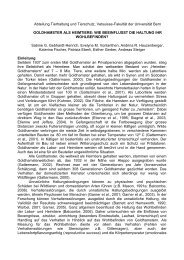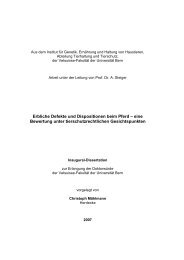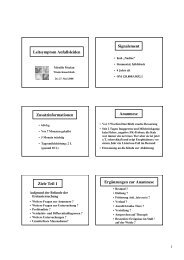Lifespan and Causes of Death in the Irish Wolfhound - Vetsuisse ...
Lifespan and Causes of Death in the Irish Wolfhound - Vetsuisse ...
Lifespan and Causes of Death in the Irish Wolfhound - Vetsuisse ...
Create successful ePaper yourself
Turn your PDF publications into a flip-book with our unique Google optimized e-Paper software.
3.7.1.3 Diagnosis<br />
The def<strong>in</strong>ite diagnosis <strong>of</strong> FCE can only be made post-mortem through<br />
histopathological exam<strong>in</strong>ation <strong>of</strong> <strong>the</strong> sp<strong>in</strong>al chord, comb<strong>in</strong>ed with special sta<strong>in</strong><strong>in</strong>g<br />
techniques to demonstrate <strong>the</strong> presence <strong>of</strong> cartilag<strong>in</strong>ous material <strong>in</strong>side medullary<br />
blood vessels (Junker, van den Ingh et al. 2000). Never<strong>the</strong>less, FCE can be strongly<br />
suspected <strong>in</strong> vivo if <strong>the</strong> follow<strong>in</strong>g diagnostic criteria are met:<br />
Neurological exam<strong>in</strong>ation reveals sp<strong>in</strong>al <strong>in</strong>jury <strong>of</strong> widely vary<strong>in</strong>g location <strong>and</strong> severity.<br />
Diagnostic criteria <strong>in</strong>clude acute onset, absence <strong>of</strong> pa<strong>in</strong>, usually (though not always)<br />
asymmetrical neurological signs, a history <strong>of</strong> trauma <strong>and</strong>/or exercise shortly before<br />
<strong>the</strong> onset, <strong>and</strong> non-progressive symptoms after 12-24 hours at most. If <strong>the</strong> symptoms<br />
cont<strong>in</strong>ue to progress after this time, o<strong>the</strong>r causes <strong>of</strong> neuromalacia should be<br />
considered.<br />
Sp<strong>in</strong>al radiographs are usually normal. Myelography <strong>of</strong>ten shows focal <strong>in</strong>tramedullary<br />
swell<strong>in</strong>g <strong>in</strong> <strong>the</strong> acute stage. Later on, it can be normal or <strong>in</strong>dicate focal medullary<br />
atrophy. MRI is currently <strong>the</strong> best available diagnostic technique, with <strong>the</strong> responsible<br />
disc show<strong>in</strong>g a decreased <strong>and</strong> <strong>the</strong> <strong>in</strong>farcted medullary area show<strong>in</strong>g an <strong>in</strong>creased<br />
signal <strong>in</strong>tensity on T2 images. However, its limited availability <strong>and</strong> <strong>the</strong> need for fast<br />
action <strong>in</strong> acute cases can limit its practical use.<br />
Fur<strong>the</strong>rmore, a cerebrosp<strong>in</strong>al fluid analysis can be performed. In <strong>the</strong> acute stage, it<br />
may show a high RBC <strong>and</strong> mildly high neutrophile count; later on, only mildly<br />
elevated prote<strong>in</strong> may be observed. Normal results are also possible at all stages,<br />
however.<br />
Differential diagnoses <strong>in</strong>clude o<strong>the</strong>r forms <strong>of</strong> sp<strong>in</strong>al <strong>in</strong>jury such as fractures <strong>and</strong><br />
luxations, which are usually associated with pa<strong>in</strong> <strong>and</strong> visible on a sp<strong>in</strong>al radiography;<br />
or sp<strong>in</strong>al tumours (Vaughan-Scott, Gold<strong>in</strong> et al. 1999), where signs can be expected<br />
to be slowly progressive ra<strong>the</strong>r than acute. Fur<strong>the</strong>rmore, medullary haemorrhage due<br />
to <strong>in</strong>gestion <strong>of</strong> rodenticides, thrombocytopenia or DIC should be considered <strong>and</strong><br />
excluded through a haematological exam. Last, focal myelitis is also a possibility, but<br />
can be differentiated by its progressive symptoms <strong>and</strong> characteristic changes <strong>in</strong> <strong>the</strong><br />
cerebrosp<strong>in</strong>al fluid (Sisson <strong>and</strong> Parent 2004).<br />
Sex Age (wks) Trauma? Cl<strong>in</strong>ical Diagnosis<br />
Pathology<br />
m 9 yes (play) Tetraparesis/-plegia; problem C1-C6 FCE C5-C7<br />
m 12.5 yes (slid) Monoparesis; left h<strong>in</strong>d limb FCE T1-T7<br />
m 8 unknown Hemiparesis/-plegia FCE C6-C7<br />
m 10 unknown Hemiparesis FCE C5-T3<br />
f 8 no Paresis posterior FCE<br />
m 11 no Monoparesis/-plegia; left h<strong>in</strong>d limb recovered<br />
m 10 yes (walk) Monoparesis; left h<strong>in</strong>d limb recovered<br />
m 11 no Paresis posterior; problem T2-L3 recovered<br />
Table 3.5: Summary <strong>of</strong> cl<strong>in</strong>ical presentation data from 8 <strong>Irish</strong> <strong>Wolfhound</strong> puppies<br />
diagnosed or suspected with FCE over a 16-month period between 1996-1997 at<br />
Utrecht university; taken from Junker, van den Ingh et al. (2000). Note that <strong>the</strong><br />
def<strong>in</strong>ition <strong>of</strong> "trauma" is to be <strong>in</strong>terpreted generously, which could <strong>in</strong>terfere with <strong>the</strong><br />
cases where no trauma was reported.<br />
35



